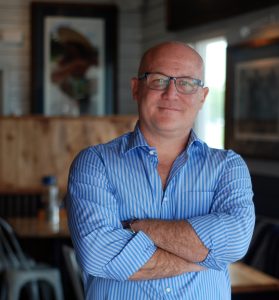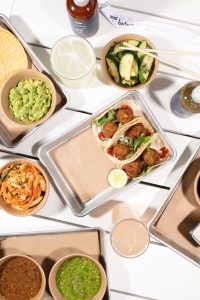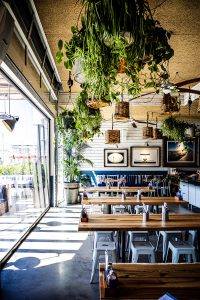As CEO Scott Lawton spurs the growth of Virginia-based Bartaco beyond its Mid-Atlantic home, he’s focused on avoiding some of the traps that have degraded the previous class of once-buzzy restaurants, especially homogenization.

Bartaco co-founder and CEO Scott Lawton
Highlighting his previous experience in fine dining, Lawton says Bartaco is intended to be a brand of consequence—and one with a higher purpose than unit growth. At 25 up-and-running locations, the co-founder and CEO says reaching that higher plane will be a combination of listening to its customers, having the courage to try new things, and using technology to improve its guest relationships without being creepy.
“I love a real experience, I love something that’s tangible and real, that doesn’t feel homogenized, duplicated and overly scaled, if you will,” Lawton said of the 13-year-old brand. While expanding into new cities like Chicago is a nice, big step, the CEO’s priorities are building a larger brand “that matters to people, a brand that becomes part of their lives without it becoming all those things you see chain restaurants do sometimes.”
It’s all part of what the CEO calls an “introspective” brand that’s taking pains to avoid grinding off its sharp edges and best ideas in the name of growth.
Avoiding being creepy isn’t a joke in the mold of Google’s once-touted “don’t be evil” code of ethics, it’s increasingly material given the industry’s shift to data-driven decisions. With so many new sources of customer information and tools to analyze that data, restaurants can use increasingly precise data points to inform real estate research, creating more connections with loyal fans beyond just discounts, and even setting a pricing strategy that is tailored to each ordering channel.
Lawton also doesn’t want Alexa overhearing Bartaco references, with targeted ads suddenly appearing on Instagram.

A Bartaco location on New Paces Ferry Road in Atlanta.
“When we started this brand, we didn’t say we want to sell tacos, we said we want to create this beach getaway, this escape from the moment, this helpful place where people can have fun and feel really comfortable,” he said. “We’re still living by all those rules, we’re just not living by the rules that the industry has set for us.”
Getting shift-by-shift, store-level data on a daily basis has been especially beneficial to the operations team, allowing the corporate office to determine what’s going wrong at a given location, while also making it clear how to solve the problem.
“We’re able to fix things in a much more targeted way,” he said. “What I’ve seen so far from the data is we’re pretty dead on with the brand that we think customers would like, the type of food we sell and they want to be engaged—we know that. Now, it’s how we can leverage all these new tools we have in our toolbox and do the best job of that.”
Better order throttling

Twelve percent of Bartaco sales fall under the takeout bucket, with 7 percent coming from third-party delivery providers.
At present, 12 percent of Bartaco sales fall under the takeout bucket, with 7 percent coming exclusively from third-party delivery providers. To preserve food quality, while subtly reminding delivery customers of the superior dine-in experience, tacos are only sold through delivery apps in unassembled four- and eight-packs.
Those taco packs help preserve food quality by keeping proteins, cool or toppings and tortillas separated, which provides countless benefits to off-premises eaters. It’s also an offshoot of Lawton’s belief that third-party providers aren’t true partners of restaurants regardless of their messaging, citing the early days in the category that included menu scraping and delivering meals without brand approval.
These days, after negotiating Bartaco’s delivery commissions down “so we don’t completely lose ourselves,” he feels that national delivery providers are no longer predatory, but definitely still not bff’s. “I wouldn’t call them a partner, because a partner wouldn’t do that,” he said of third-party customer data collection.
Looking ahead, Bartaco is investigating a new back-of-the-house kitchen display system that knows how many orders are coming in, but also tracks the kitchen’s capacity for additional orders. That upgrade will help the brand throttle outside delivery orders since its kitchens are often maxed out keeping up with in-store orders.
“We would certainly do more sales if we did more advertising [on delivery apps], but it’s a big chunk out of the bottom line,” Lawton added. “For us, our capacity is at a certain point where I’m not looking to juice it.”
Rather than artificially spurring third-party sales, the primary focus is continued organic growth of the delivery channel, which he said is easier for brands that are sought after and have highly differentiated menus—rather than aimless delivery customers searching for “Mexican” online.
Lawton said the brand opened two ghost kitchen locations during the pandemic, which were intended to take pressure off of traditional kitchens at rush periods. Lawton said both were closed because they weren’t making money.
“That’s the program with most ghost kitchens,” he added. “When you’re getting more complex with a lot more SKUs, then it’s really hard to execute that as a ghost kitchen, because you can’t put that many staff in and make it reasonable.”
 The average age of Bartaco’s customers is 31, which skews about 65 percent female. All future expansion looks for those look-alike demographics, which includes the upcoming downtown Charleston, South Carolina, market. Even though it’s not a big city, it also pulls in tourists and relocated residents from Atlanta, North Carolina and New England where the brand already has significant brand awareness.
The average age of Bartaco’s customers is 31, which skews about 65 percent female. All future expansion looks for those look-alike demographics, which includes the upcoming downtown Charleston, South Carolina, market. Even though it’s not a big city, it also pulls in tourists and relocated residents from Atlanta, North Carolina and New England where the brand already has significant brand awareness.
“There’s a hub-and-spoke theory there, go to the downtown area and open a cool Bartaco that’s really differentiated, [and] then you can grow as that brand equity grows in the market, which I think is a more sustainable way of running the business,” Lawton said.
After opening its latest store in Washington, D.C., Lawton said he expects growth to remain at a steady pace, looking at five to six new stores every year, then growing to a new location every month or two.
Staffing has been a particular challenge in the Georgia market, after making progress on getting the right leaders in place in Florida—where the brand is working especially hard to grow awareness.
Part of Lawton’s to-do list includes getting out there in industry publications and events, getting the employer-side messaging out there and projecting he and the brand’s point of view wherever possible.
“If we do a good job over the next couple of years, maybe we’ll grow faster. If we don’t, then we’ll grow slower,” he said. “The grand experiment for me is building this brand and making it real and making it tangible and making it important— not waking up X number of years from now going, ‘Oh, remember when that was a cool brand?’”



